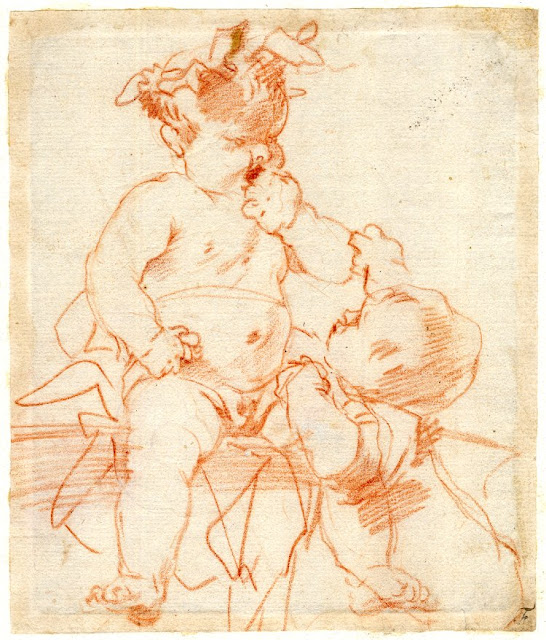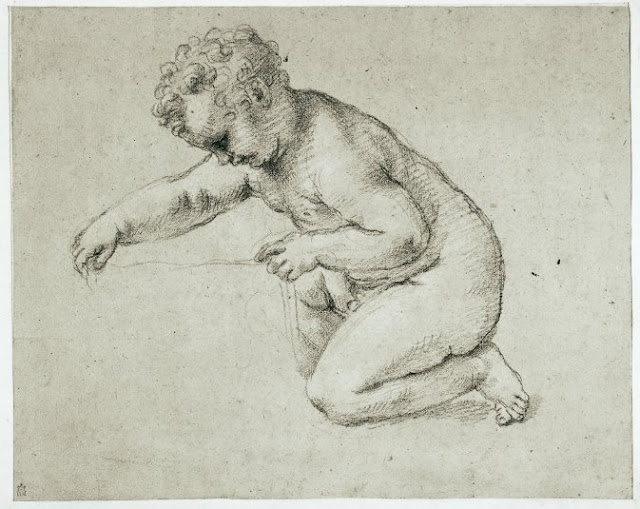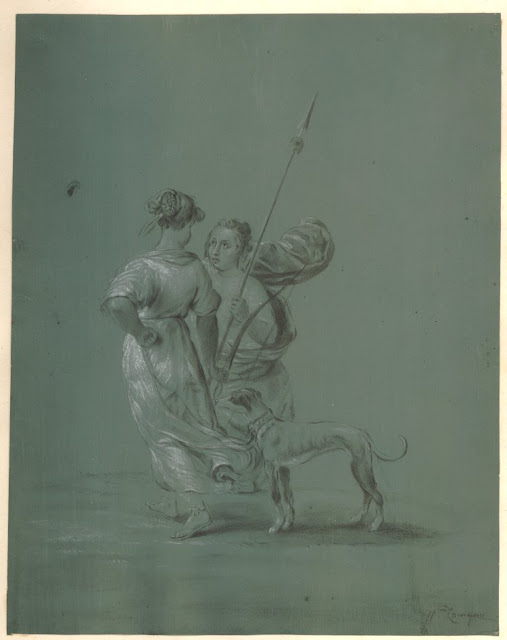 |
| attributed to Alessandro Gherardini Putti before 1723 drawing from the Cavendish Album British Museum |
 |
| attributed to Luigi Garzi Kneeling putto lifting cloth before 1721 drawing from the Cavendish Album British Museum |
 |
| Giuseppe Passeri Studies of infants before 1714 drawing from the Cavendish Album British Museum |
ON THE DIALECTIC OF TACT
"The precondition of tact is convention no longer intact yet still present. Now fallen into irreparable ruin, it lives on only in the parody of forms, an arbitrarily devised or recollected etiquette for the ignorant, of the kind preached by unsolicited advisers in newspapers, while the basis of agreement that carried those conventions in their human hour has given way to the blind conformity of car-owners and radio-listeners. . . . Other than convention, there is nothing by which tact could be measured. Convention represented, in however etiolated a form, the universal which made up the very substance of the individual claim. Tact is the discrimination of differences. It consists in conscious deviations. Yet when, emancipated, it confronts the individual as an absolute, without anything universal from which to be differentiated, it fails to engage the individual and finally wrongs him. The question as to someone's health, no longer required and expected by upbringing, becomes inquisitive or injurious; silence on sensitive subjects becomes empty indifference, as soon as there is no rule to indicate what is and what is not to be discussed. Thus individuals begin, not without reason, to react antagonistically to tact: a certain kind of politeness, for example, gives them less the feeling of being addressed as human beings than an inkling of their inhuman conditions, and the polite run the risk of seeming impolite by continuing to exercise politeness, as a superseded privilege. In the end, emancipated, purely individual tact becomes mere lying."
– from Minima Moralia (1951) by Theodor Adorno, translated by E.F.N. Jephcott (1974)
Adorno's example of the "tactful silence" should resonate with all viewers of what is now called "heritage drama." In Jane Austen, active silence is the norm, a silence aware of itself and perceptible to its audience as a unique and valuable form of speech. Two centuries later, in Ann Beatty or Raymond Carver, silence can only be empty.
 |
| Francesco Fernandi Head of a boy looking upward before 1720 drawing on blue paper from the Cavendish Album British Museum |
 |
| Anonymous artist working in Naples Head of a man in a turban 18th century drawing from the Cavendish Album British Museum |
 |
| Giuseppe Passeri Portrait of a Prelate ca. 1700 drawing on blue paper from the Cavendish Album British Museum |
 |
| Carlo Maratti Head of a woman in profile looking upward before 1713 drawing on blue paper from the Cavendish Album British Museum |
 |
| Carlo Maratti Study for statue of St John the Evangelist carved by Rusconi for niche designed by Borromini at St John Lateran, Rome ca.1703 drawing from the Cavendish Album British Museum |
 |
| William Comyn (active in Venice) Portrait of a man in the guise of a philosopher before 1720 drawing from the Cavendish Album British Museum |
 |
| William Comyn (active in Venice) Two young women hunting with a dog before 1720 drawing from the Cavendish Album British Museum |
 |
| Pietro de' Pietri Adoration of Magi before 1716 drawing from the Cavendish Album British Museum |
 |
| Giuseppe Passeri Holy Family and Saints before 1714 drawing from the Cavendish Album British Museum |
 |
| Giuseppe Passeri Birth of the Virgin ca. 1707 drawing from the Cavendish Album British Museum |
 |
| attributed to Henry Trench Venus and Cupid ca. 1700 drawing on blue paper from the Cavendish Album British Museum |